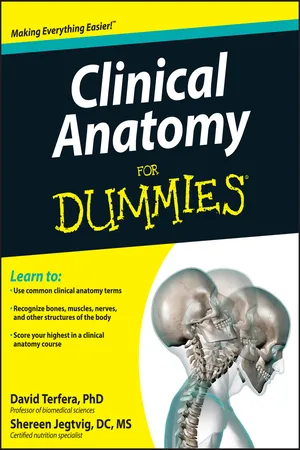

- English
- ePUB (mobile friendly)
- Available on iOS & Android
Clinical Anatomy For Dummies
About this book
Your ticket to acing Clinical Anatomy
Clinical anatomy is the study of human anatomy as it relates to clinical practice. Unlike a basic anatomy and physiology course designed to teach general anatomical knowledge, clinical anatomy focuses on specific structures and issues that people may encounter in a clinical setting.
Clinical Anatomy For Dummies presents a friendly, unintimidating overview of the material covered in a typical college-level Clinical Anatomy course. Clear definitions, concise explanations, and plenty of full-color illustrations make Clinical Anatomy For Dummies the most accessible book available to supplement your classroom texts.
- Plain-English explanations make difficult concepts easy to grasp
- Tracks to a typical college-level Clinical Anatomy course
- Features a 16-page color insert
Whether you're a student or a practicing healthcare worker, Clinical Anatomy for Dummies makes this subject accessible and easy to grasp.
Frequently asked questions
- Essential is ideal for learners and professionals who enjoy exploring a wide range of subjects. Access the Essential Library with 800,000+ trusted titles and best-sellers across business, personal growth, and the humanities. Includes unlimited reading time and Standard Read Aloud voice.
- Complete: Perfect for advanced learners and researchers needing full, unrestricted access. Unlock 1.4M+ books across hundreds of subjects, including academic and specialized titles. The Complete Plan also includes advanced features like Premium Read Aloud and Research Assistant.
Please note we cannot support devices running on iOS 13 and Android 7 or earlier. Learn more about using the app.
Information



Table of contents
- Cover
- Table of Contents
- Title Page
- Introduction
- Part I: Beginning with Clinical Anatomy Basics
- Part II: Understanding the Thorax, Abdomen, and Pelvis
- Part III: Looking at the Head, Neck, and Back
- Part IV: Moving to the Upper and Lower Extremities
- Part V: The Part of Tens